The food lab better home cooking through science ( PDFDrive ) 453
Bạn đang xem bản rút gọn của tài liệu. Xem và tải ngay bản đầy đủ của tài liệu tại đây (222.48 KB, 2 trang )
SALMONTHATDOESN’TSTINK
Ihatesalmon.
With a passion. Chalky, dry, smelly, slimy-skinned, the
worstoftheworstwhenitcomestofish.
Atleast,that’swhatIwould’vesaidaboutadecadeago,
when the only salmon I had tasted was the overpoached
stuffatbuffetsorovercookedspecimensatrestaurantsthat,
frankly,didn’tknowwhattheyweredoing.Idon’tknowifI
wasrunningintherightcircles,butitseemedderigueurin
myyouthforeveryonetocooksalmontoashadejustpast
well-done. We didn’t exit these culinary dark ages until
sometime in the 1990s, by which time my bias against the
fishhadbeenfirmlyestablished.
It wasn’t until I started cooking in nice restaurants (the
kind that I could never afford to go to as a civilian) that I
realizedthatitwasn’tthesalmonthatwasatfault,butrather
the cook. Properly cooked salmon is amazing, whether it’s
gotcrisp,cracklyskinthatcanrivalthebestroastchicken’s
or tender, moist, flavorful meat that melts on your tongue
like butter (or sometimes both!).There’s a reason after all,
why salmon is the most popular fresh fish in this country,
andwhyit’sthefishI’vechosentoworkmainlywithhere.
That said, the techniques I’m going to discuss apply to
anythick,robustfishfillets,suchashalibut,redsnapper,or
seabass.
PAN-SEARINGSALMON
There’s an unholy trinity of fates that can befall salmon. If
you’ve ever cooked salmon, these are probably all too
familiarsights:
ThePickedScab
Flaky bits of salmon flesh that get stuck to the pan as it
cooks. Not only does it make the cooked fillet look like a
pockmarked teenage crater-face, it also makes the pan a
bitchandahalftocleanwhenyou’redone.
TheLeatherhead









